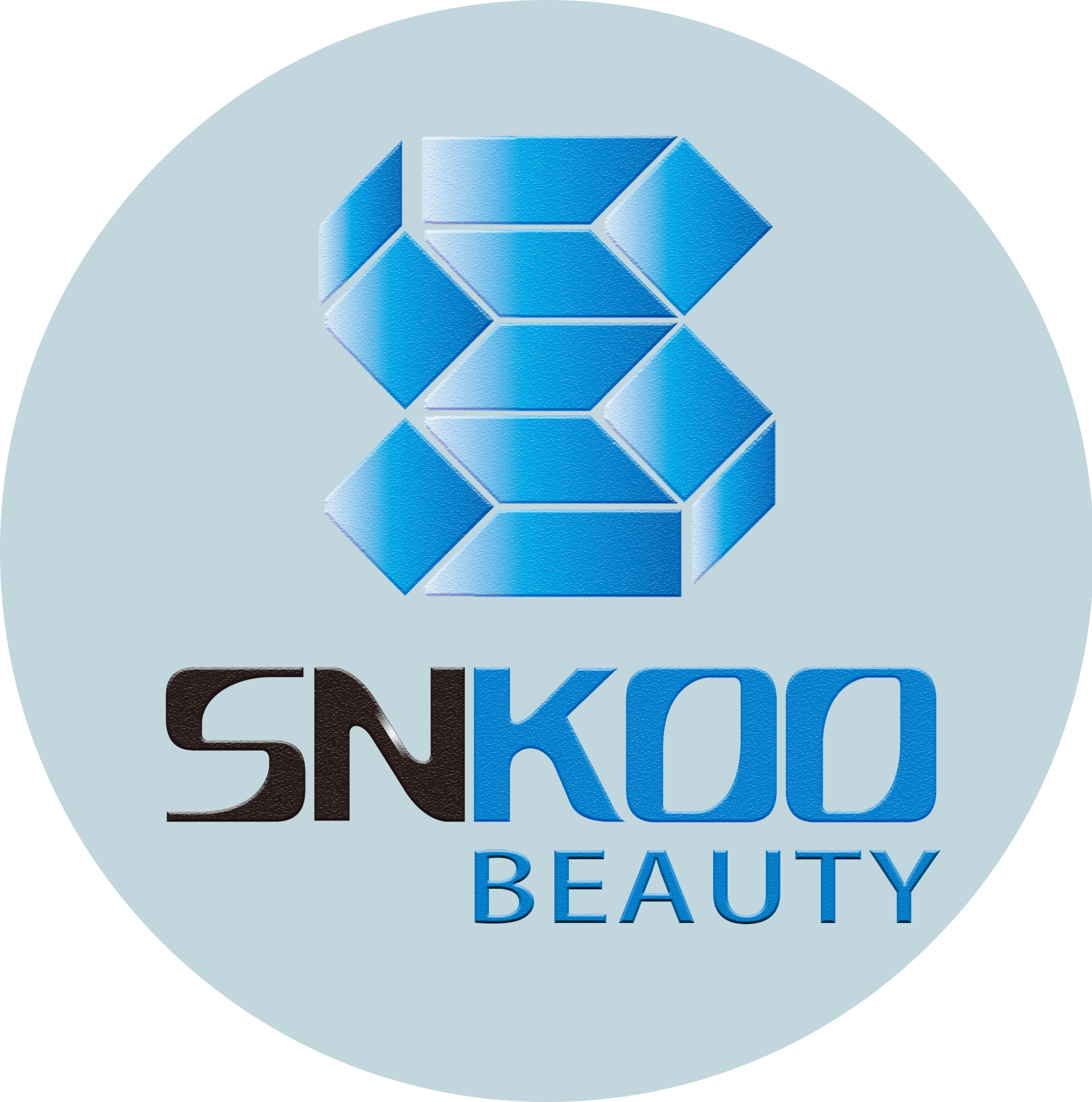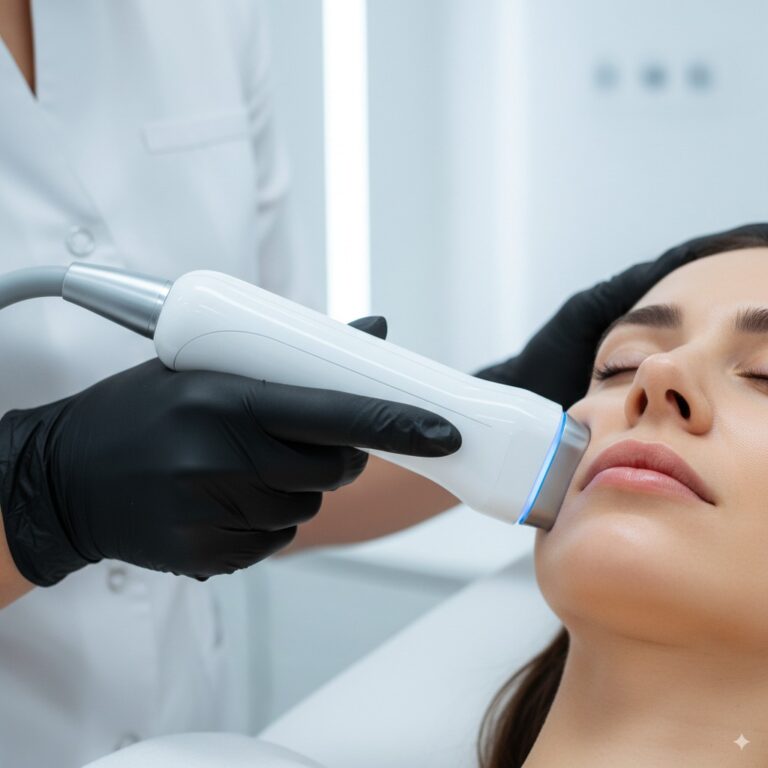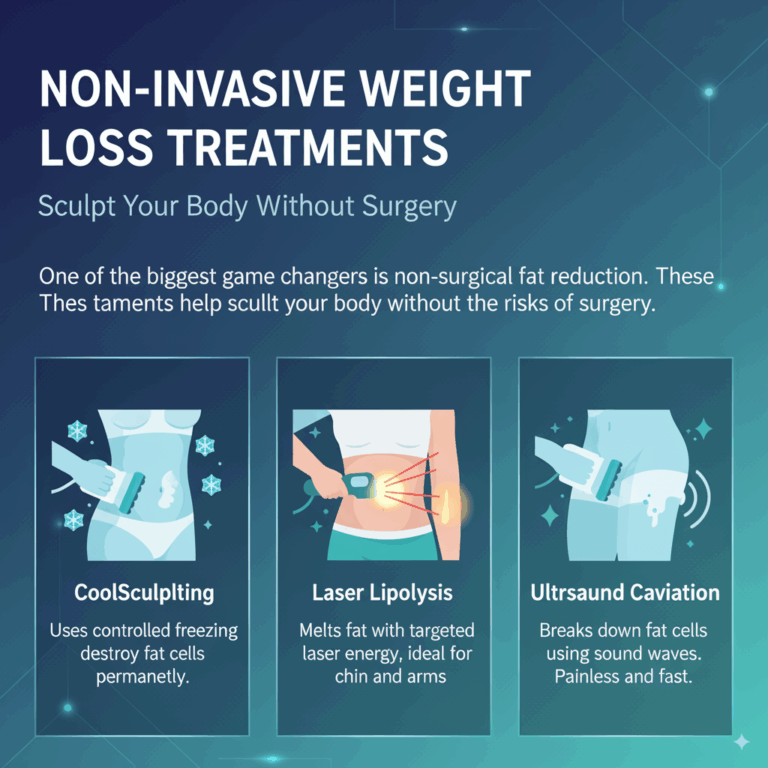The Future is Now: Exploring the Power of Cold Plasma Technology in Medical Aesthetics
When we think of the fundamental states of matter, our minds usually jump back to high school science class: solid, liquid, and gas. But what if I told you there’s a fourth, electrifying state that holds the key to unlocking some of the most revolutionary advances in modern skincare? This isn’t science fiction; it’s science fact. We’re talking about plasma, and more specifically, the groundbreaking use of cold plasma technology in medical aesthetics.
For years, the aesthetic industry has been dominated by lasers, fillers, and peels. While effective, they each have their own set of limitations. Now, a new contender has entered the ring, armed not with light or needles, but with the controlled energy of ionized gas. It promises to tighten skin, revise scars, combat acne, and rejuvenate the complexion without the need for a single incision. But how does this futuristic technology actually work? Is it truly the game-changer it’s hyped up to be? Let’s pull back the curtain and explore the incredible power of cold plasma, a force that’s reshaping our approach to non-invasive beauty.
What Exactly is Cold Plasma? Unveiling the Fourth State of Matter
Before we dive into its aesthetic applications, let’s get a handle on what plasma actually is. Simply put, if you take a gas and apply enough energy to it (like heat or an electrical field), you can knock electrons free from their atoms. This process, called ionization, creates a cloud of charged ions and free electrons. This energized, electrically conductive gas is plasma. You see it every day in the form of lightning, the stars, and even the glow of a fluorescent light bulb. It’s the most abundant state of matter in the universe.
Now, the word “plasma” might conjure images of scorching hot temperatures, and you wouldn’t be wrong. The plasma in the sun, for example, is millions of degrees Celsius. This is where the distinction becomes crucial. The technology we’re talking about is cold plasma.
More Than Just Hot Gas: Defining “Cold” Plasma
The term “cold plasma” (also known as non-thermal plasma) can be a bit misleading. It’s not “cold” in the way an ice cube is. Instead, it means the plasma is at or near room temperature. How is this possible? The energy in cold plasma isn’t distributed as thermal heat. Instead, the energy is held by the high-velocity electrons while the heavier ions and neutral atoms remain relatively cool.
Think of it like a crowded dance floor. The electrons are the hyperactive dancers zipping around with incredible energy, while the larger ions and atoms are the people standing still or moving slowly. Even though there’s a ton of energy on the dance floor (the electrons), the overall temperature of the room (the gas) doesn’t skyrocket. This brilliant principle allows us to harness the immense reactive power of plasma and apply it directly to the skin without causing a thermal burn, opening up a whole new world of safe and effective treatments.
How Does Cold Plasma Work Its Magic on the Skin?
So, we have this room-temperature, energized gas. How does that translate into tighter, clearer, more youthful skin? The magic lies in the precise way cold plasma interacts with our skin cells and the surrounding tissue. It’s not a single-action process but a beautiful symphony of biological responses triggered by a tiny, controlled spark.
The Science Simplified: From Gas to a Rejuvenating Spark
Most cold plasma devices used in aesthetics look like a pen or a wand. This device uses electricity to ionize the gas in the air between its tip and your skin—usually nitrogen and oxygen. This creates a tiny, focused arc of plasma that looks like a miniature lightning bolt. This arc is the workhorse of the treatment.
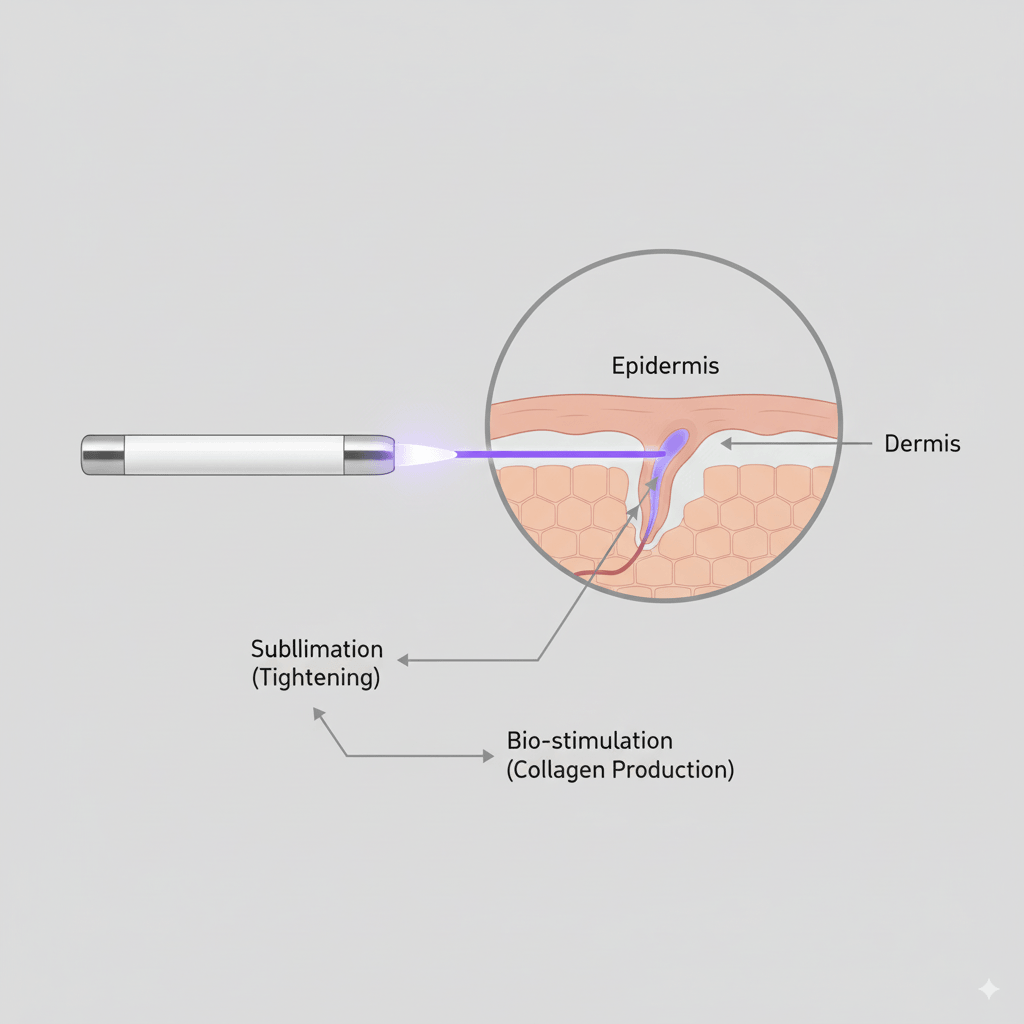
When this plasma arc touches the skin’s surface, it transfers its energy in a very targeted way. It doesn’t burn through the skin like a laser. Instead, it triggers two primary mechanisms that work together to produce incredible results: sublimation and bio-stimulation.
A Tale of Two Actions: Sublimation and Bio-stimulation
First, let’s talk about sublimation. This is a physical process where a solid turns directly into a gas, skipping the liquid phase entirely. When the plasma arc hits the very outer layer of the epidermis, it instantly vaporizes, or “sublimates,” a tiny dot of skin tissue. This action creates a micro-injury that serves a powerful purpose. As the skin heals from this controlled injury, it powerfully contracts and tightens, pulling the cells closer together. Imagine a piece of fabric and pulling on dozens of tiny threads at once—the entire fabric becomes tighter and smoother. This is the principle behind the famous “fibroblasting” or “plasma pen” treatments for skin tightening.
But that’s only half the story. The energy from the plasma doesn’t just stop at the surface. It also creates a cascade of biological responses deeper within the skin, a process we can call bio-stimulation.
- Collagen and Elastin Activation: The controlled micro-trauma and energy transfer send a powerful wake-up call to the fibroblast cells in the dermis. These are the “factory” cells responsible for producing collagen and elastin—the proteins that give our skin its structure, firmness, and bounce. The plasma energy stimulates these fibroblasts to ramp up production, rebuilding the skin’s supportive framework from the inside out over the weeks and months following treatment.
- Sterilization and Inflammation Reduction: Cold plasma is incredibly effective at killing bacteria, viruses, and fungi. It disrupts their cellular membranes, making it a potent tool for treating conditions like active acne. It sterilizes the skin, reduces inflammation, and can even help balance sebum (oil) production, creating a less hospitable environment for future breakouts.
- Enhanced Cellular Function: The plasma energy can temporarily alter the electrical potential of the skin’s cell membranes. This makes the cells more permeable and “receptive,” a bit like opening tiny doors on the cell surface. This not only improves the transport of nutrients and removal of waste but also dramatically increases the skin’s ability to absorb topical products, a principle used in “plasma shower” treatments.
The Transformative Applications: Where Cold Plasma Shines
Now for the really exciting part: what can this technology actually do for you? Because of its unique, multi-faceted approach, cold plasma is incredibly versatile. Here are some of its most popular and effective applications in medical aesthetics.
The Non-Surgical Eyelid Lift (Blepharoplasty)
This is perhaps the most famous application of plasma technology. For individuals with mild to moderate “hooding” of the upper eyelids or crepey skin under the eyes, cold plasma offers a remarkable non-surgical alternative to a traditional blepharoplasty. By placing a pattern of sublimation dots on the excess skin, the practitioner can trigger a significant tightening and lifting effect as the area heals, revealing a more open and youthful eye area.
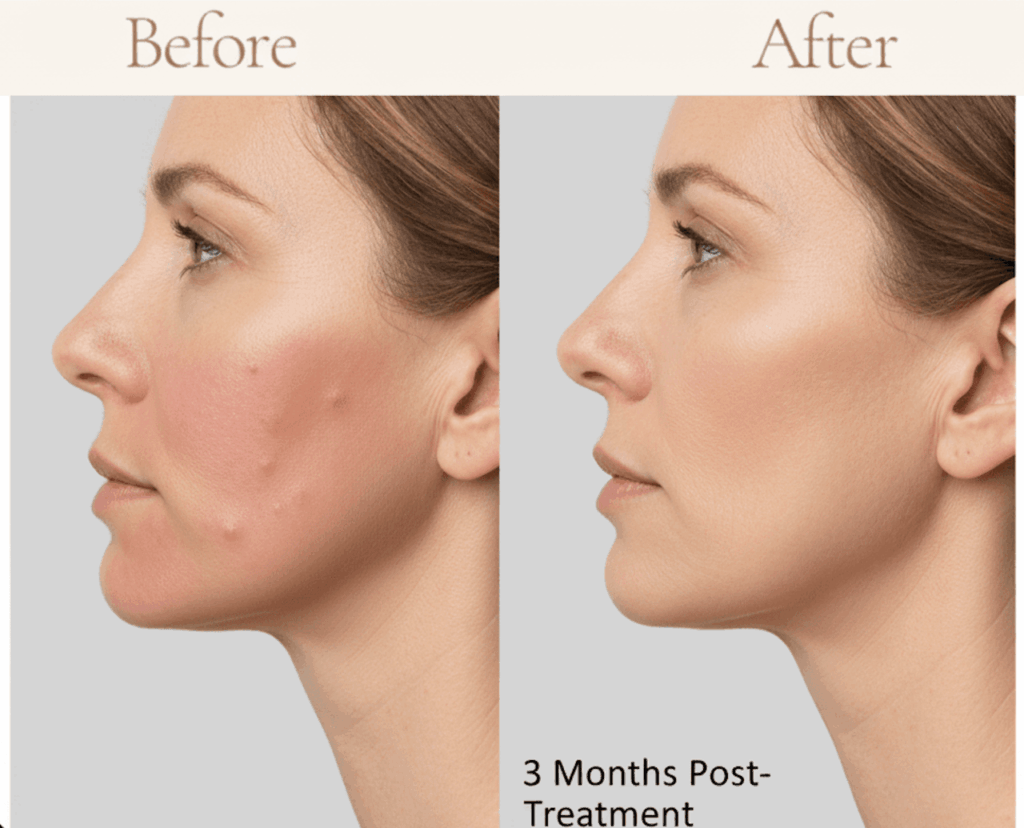
Wrinkle Warrior: Smoothing Fine Lines and Tightening Skin
The same sublimation and bio-stimulation principles are powerhouses for combating wrinkles and laxity across the face and body. It’s particularly effective for stubborn areas that are difficult to treat with other modalities, such as:
- Perioral lines (“smoker’s lines”) around the mouth.
- Crow’s feet around the eyes.
- Forehead lines.
- Nasolabial folds.
- Jowls and sagging along the jawline.
- Neck lines (“tech neck”) and décolletage.
The tightening is immediate, but the real magic unfolds over the next 2-3 months as new collagen is produced, leading to smoother, firmer, and more resilient skin.
The Acne Annihilator: A New Hope for Clear Skin
For those battling persistent acne, cold plasma offers a completely new weapon. Treatments like the “plasma shower,” which don’t involve sublimation dots, use the broad application of plasma to leverage its powerful antibacterial and anti-inflammatory properties. The plasma energy effectively neutralizes the P. acnes bacteria responsible for breakouts, calms the associated redness and inflammation, and helps to regulate oil production over time. It can also be used to improve the texture and appearance of atrophic acne scars by stimulating collagen remodeling in the affected areas.
The Ultimate Booster: Enhancing Topical Product Absorption
Remember those tiny doors we mentioned plasma opening on the cell surface? This effect, known as temporary cell membrane permeabilization, is revolutionary. By passing the plasma device over the skin in a “shower” or “painting” motion, we can make the skin up to 120 times more absorbent for a short period. This allows potent serums—packed with hyaluronic acid, vitamin C, growth factors, or other active ingredients—to penetrate far deeper than they ever could on their own, dramatically amplifying their effectiveness. It’s like turning your skin into a super-sponge for all the good stuff.
The Cold Plasma Experience: What to Realistically Expect
If you’re considering a cold plasma treatment, it’s essential to have a clear picture of the process. Your journey will begin with a thorough consultation with a qualified and certified practitioner. This is not a one-size-fits-all treatment, and a professional needs to assess your skin type, concerns, and medical history to determine if you are a suitable candidate.

For skin tightening (fibroblasting) treatments, a topical numbing cream is typically applied for 45-60 minutes to ensure your comfort. During the procedure, you may feel a slight warmth and hear a zapping sound as the plasma arc is formed, but it’s generally well-tolerated.
The immediate aftermath is the most important part to prepare for. The treated area will be covered in tiny brown dots, which are the carbon crusts from the sublimation process. You can also expect some swelling (especially around the eyes) and redness for the first 2-3 days. This is a normal part of the healing process.
Aftercare is critical. You’ll be instructed to keep the area clean and dry and to let the carbon crusts fall off naturally, which usually takes about 5-10 days. Under no circumstances should you pick at them, as this can lead to scarring or infection. Once the dots are gone, the new skin underneath may appear pink for a few weeks, and it is absolutely vital to protect it with a high-SPF sunscreen to prevent hyperpigmentation.
Conclusion: Is This a Fleeting Trend or the Future of Skincare?
With its unique ability to tighten, resurface, sterilize, and regenerate skin tissue with such precision, cold plasma technology is far more than just a passing fad. It represents a significant leap forward in non-invasive aesthetic medicine. It bridges the gap between topical treatments and aggressive surgical procedures, offering dramatic, long-lasting results with significantly less risk and downtime.
From lifting hooded eyes to clearing stubborn acne, the applications are as diverse as they are effective. Of course, as with any powerful tool, the results are entirely dependent on the skill of the artist wielding it. Seeking out a highly trained, certified, and experienced practitioner is non-negotiable. But in the right hands, cold plasma is proving to be one of the most exciting and transformative technologies to hit the beauty industry in decades. It’s not just a spark of genius; it’s the fourth state of matter, and it’s here to revolutionize the way we care for our skin.
Frequently Asked Questions (FAQs)
1. Is cold plasma treatment painful? For skin tightening treatments (fibroblasting), a strong topical anesthetic is applied beforehand, making the procedure quite comfortable for most people. You might feel a sensation of warmth or a light flicking against the skin. “Plasma shower” treatments for acne or product absorption are virtually painless and do not require numbing cream.
2. How is cold plasma different from a laser treatment? While both use energy, the mechanism is entirely different. Lasers use a single wavelength of light to heat a specific target (like water, pigment, or blood). Plasma is an energized gas that works through sublimation and electrical energy transfer. This means plasma doesn’t depend on a “chromophore” target and can be used on a wider range of skin types. Importantly, it doesn’t transfer heat to the surrounding tissue in the same way a laser does, which can often mean a different healing profile.
3. Who is a good candidate for cold plasma? Ideal candidates are typically those with mild to moderate skin laxity, fine lines, wrinkles, acne-prone skin, or atrophic scars. It is most effective on individuals with lighter skin tones (Fitzpatrick skin types I-III), as there is a lower risk of post-inflammatory hyperpigmentation. A thorough consultation is necessary to determine if the treatment is right for your specific goals and skin type.
4. How many sessions will I need? This depends entirely on the condition being treated and the desired results. For significant skin tightening, some individuals may achieve their goals after just one session. However, 2-3 sessions spaced 8-12 weeks apart may be recommended for optimal results. For acne treatments, a series of “plasma shower” sessions might be prescribed.
5. Are the results of cold plasma permanent? The skin tightening and collagen remodeling results are very long-lasting. By stimulating your body’s own regenerative processes, the treatment effectively turns back the clock. However, it does not stop the natural aging process. You will continue to age from your new, improved baseline. Most people find their results last for several years, and good skincare and sun protection can help prolong them.
